If you’re looking to shed extra pounds, boost your health and feel your best, dedicating just 30 minutes a day to physical activity can help you achieve your goals. While joining a gym is an option, with average membership fees of $50 per month, costs can add up quickly.
Why not try a better alternative? Create a simple, budget-friendly fitness space in your own home. A home gym gives you the ultimate flexibility—work out whenever it suits your schedule, day or night. You’ll have full control over your environment, from the temperature to the music, and you can spend as much time as you’d like on any exercise.
Setting up a home gym doesn’t have to break the bank. With basic, affordable equipment, you can design a space for effective strength and cardio training. In this guide, we’ll show you how to organize a functional gym in any size space, offer tips for using household items as substitutes for expensive gear, and share free resources for coaching and virtual classes. Transform your home into a fitness haven without the hefty price tag!
Step 1: Assess Your Space

Find the Perfect Spot for Your Home Gym
Basements, garages and spare bedrooms are the most common areas to set aside for regular exercise. Wherever you have room for your gym, the ideal place has good ventilation to keep the air fresh, and is well-lit and uncluttered, so you can focus on your workout.
High ceilings, if you have them, allow you to do exercises that need vertical space such as jumping rope. The floor should be non-skid and bare or with only a low-pile carpet.
Lastly, choose a place that’s convenient for you! If that’s in your living room where you can watch television while you exercise, try to create a workout corner where everything is in one place. You could also focus on curating equipment that is easy to condense or hide, such as a foldable walking pad and a set of resistance bands.
Small Space Solutions for a Home Gym
If you have limited room, free your floor space by installing shelves to hold your gear, such as dumbbells, kettlebells, stability balls and yoga mats. Put up hooks to hang resistance bands and jump ropes. For bodyweight exercises, set up a pull-up bar in a door jamb.
Step 2: Essential Equipment for a Budget-Friendly Home Gym
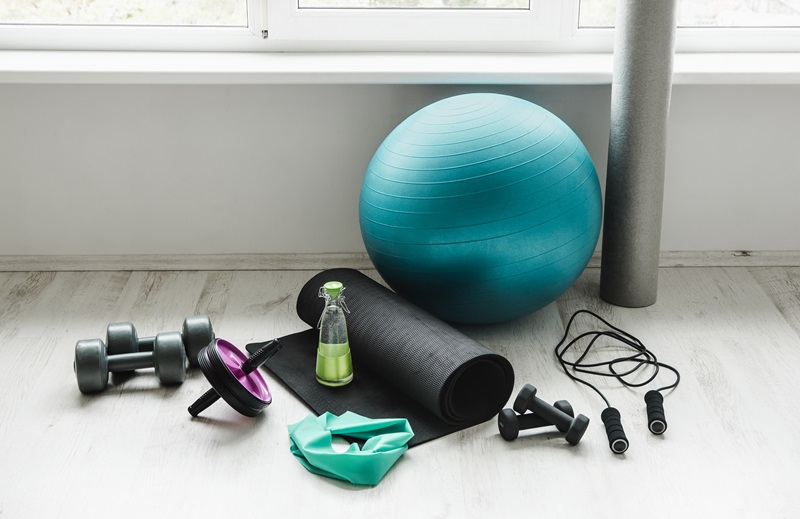
You don’t need to buy an expensive, multi-station home fitness unit to work out at home. The following items altogether cost less than $200, yet they can help you tone your muscles, gain stamina and burn calories.
1. Resistance Bands: Affordable Strength Training Made Simple
The force it takes to stretch these bands works your muscles just as if you were lifting weights or using machines, but they are inexpensive and take up little room. You’ll find lots of choices from simple, flat therapy bands to more elaborate types with handles.
Whichever you go for, pick a set of resistance bands with varying tension levels. The more strength that’s required for an exercise, the higher the resistance you’ll need from the band. Also, consider accessories that come with the bands, such as door attachments or ankle cuffs, and match them with the types of exercise you plan to do.
2. Jump Rope: Cardio That’s Fun, Efficient and Budget-Friendly
If you want a low-cost workout that bolsters your cardiovascular system while strengthening your leg muscles and burning calories, jumping rope is an efficient exercise you can do at home. Look for a jump rope with adjustable lengths to fit your body size and the space in your home gym. Many models today are made with polyurethane cables or other materials more durable than standard rope.
3. Dumbbells: The Classic Tool for Muscle Building
Sometimes called hand weights, dumbbells are small bars with equal weights on either side. They are used for strength training, which increases blood flow throughout your body as it builds muscles and heats up your metabolism.
Dumbbells come in sizes ranging from two pounds to more than 100 pounds. The right dumbbells for your home gym are heavy enough so that you feel tired after about 12 to 15 repetitions of exercises such as pressing, lifting and curling the weights. Be aware of breathing consistently during dumbbell training. Holding your breath as you strain can increase your blood pressure.
4. Stability Ball: Core Strength and Balance in One Tool
Also known as exercise balls, Swiss balls, physio balls and balance balls, these air-filled orbs are used to improve your core strength and balance while building up your muscle tone. You can use them to get more benefit from simple exercises such as crunches, squats and planks. You can even sit on the ball as you work at a desk, which keeps your core muscles activated. Balls come in different sizes, so choose one to fit your height and weight.
5. Yoga Mat: Comfort and Stability for Floor Exercises
When you want to do floor exercises, such as push-ups, yoga poses like downward dog, or to stretch your muscles for increased flexibility, a yoga mat provides stability and cushioning on any surface. Look for a mat with a textured surface for the best grip on the floor and on your feet. You’ll find inexpensive options made with PVC or more costly types made with eco-friendly materials such as bamboo.
6. Bodyweight Training Tools: Maximize Your Strength Without Weights
You can build up your strength and tone your muscles without lifting weights. Instead, you use lifting your body weight as the challenge.
Pull-up bars and push-up handles help you do bodyweight exercises for even more benefit. If you have room in your budget home gym, a dip bar and gym rings offer more exercise options.
Step 3: Optional Upgrades and Second-Hand Equipment
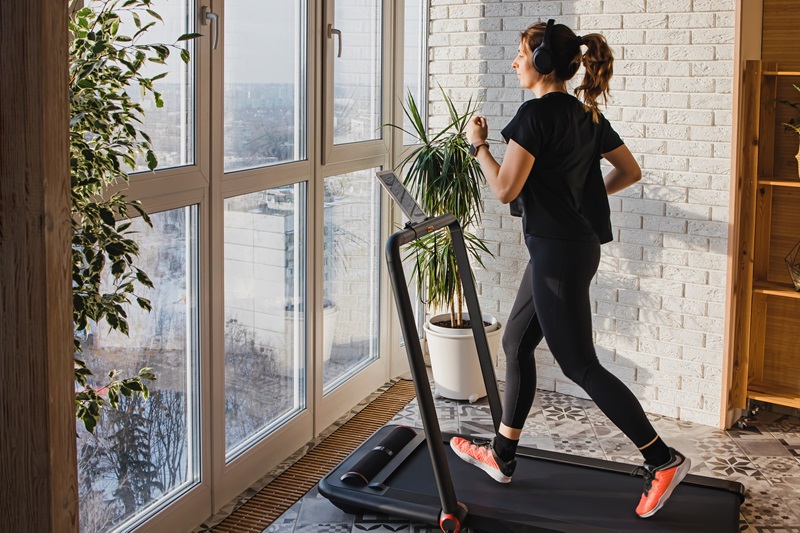
1. Kettlebells: Build Strength and Balance with Versatility
If you’ve never seen a kettlebell, they look like heavy cannonballs with a handle on top. You use them to build your strength and balance as you do exercises such as lunges, lifts and shoulder presses. If you’re new to this type of workout, start with the lightest weight kettlebells.
2. Foam Rollers: Soothe and Stretch Your Muscles
These large cylinders are most commonly used to massage large muscle groups, either as part of a warm-up to loosen up before working out or after to prevent and soothe muscle soreness. You can use a foam roller for exercises, too, such as hamstring stretches. They are made of solid foam and come in different sizes and firmness levels, depending on your needs.
3. Compact Cardio Equipment: Big Results in Small Spaces
You can find moderately priced treadmills, stationary bikes and elliptical trainers that fit into home-size spaces. Walking pads are often cheaper than treadmills and are easy to fold up and move out of the way.
If you already have a bicycle, you can buy an indoor trainer that works with your bike. Mini steppers are like StairMasters that simulate the effort of going up stairs, building up your leg and back muscles while training your cardiovascular system.
4. Second-Hand Equipment: Affordable Finds for Budget-Friendly Fitness
Many people buy home exercise equipment, use it for a short period of time and then tire of it. That means lightly used gear for your budget home gym is often available at yard sales and on Craigslist, Facebook Marketplace and other online listings.
February and March are prime times to look for them as that is when people have lost interest in equipment they bought as part of New Year’s resolution to exercise more. Remember to try out the equipment before committing to buying it to be sure it is working properly.
Step 4: DIY and Low-Cost Alternatives
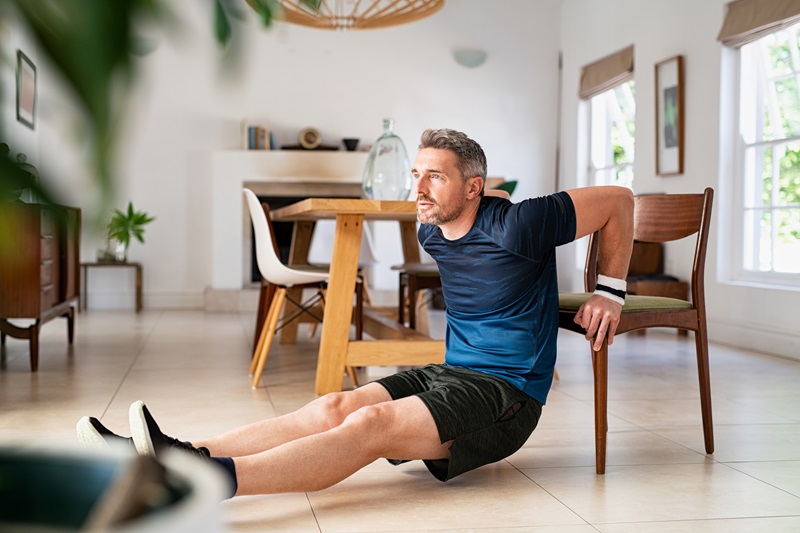
1. Homemade Equipment: Workout Tools You Already Own
Your home already has lots of items you can use for exercise:
- You don’t need a StairMaster if you have a flight of steps to go up and down.
- You can use full laundry detergent bottles, or refill them with water or sand, as hand weights.
- Do dips and other upper-body exercises on a chair.
- Set up or build a wooden cube that will serve as a plyometric box, sometimes called a jump box. It is for lower-body exercises, such as lunges, burpees and step-ups.
2. Budget-Friendly Fitness Gear: Affordable Options for Every Home Gym
If you can’t find used gear, you can pick up low-cost items at discount stores. You don’t need expensive features on basic gear such as hand weights and kettlebells. Sporting goods stores and big box outlets often offer great deals in January, when enthusiasm for exercise peaks every year.
Step 5: Setting Up and Personalizing Your Home Gym
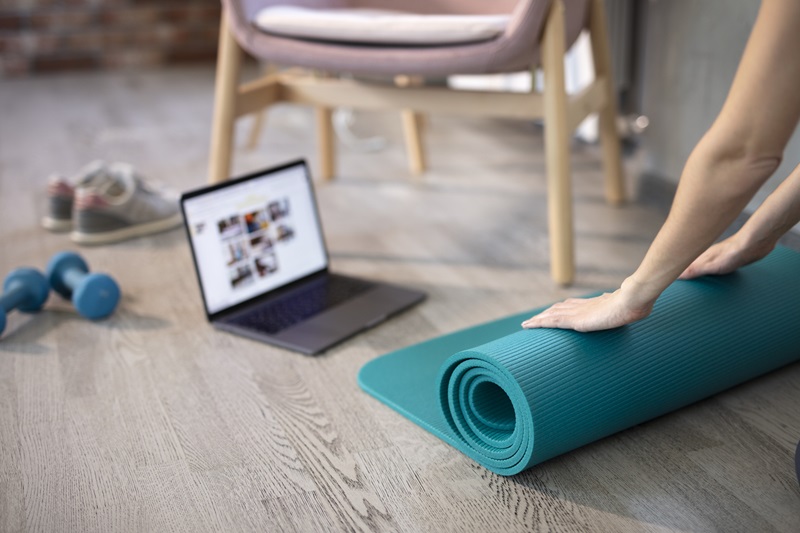
Smart Layout Ideas for a Functional Home Gym
- Optimize Your Workout Space: Create a functional gym layout with these tips:
- Use plastic storage containers to organize equipment if shelving isn’t an option.
- Leave plenty of open space to move freely without feeling constrained.
- Add a Mirror for Space and Form: A mirror makes any room feel larger while helping you check your form during exercises for safety and effectiveness.
- Use a Whiteboard to Track Workouts: Hang a whiteboard to jot down routines, track challenges and stay consistent with your fitness goals.
Creating a Motivating Environment
Boost energy and stay inspired with a vibrant, uplifting gym atmosphere.
- Energize Your Space with Bold Colors: Paint your gym in bold, energetic hues like orange, yellow, or red to promote focus and positivity.
- Use Motivational Décor: Hang posters with inspiring quotes or fitness goals to keep your mindset strong.
- Pump Up Your Workout with Music: Curate a playlist of up-tempo, high-energy songs to keep you moving and motivated during your sessions.
Step 6: Workout Plans and Free Resources
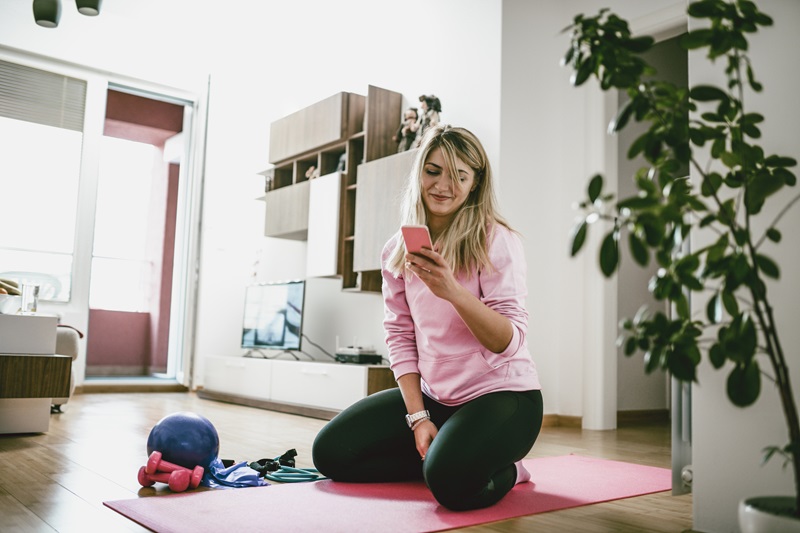
The Best Free Apps for Home Workouts
Many people today rely on smart phone and tablet apps to help guide them through their workouts. Here are some options to get you started:
- Nike Training Club has a large library of individual workouts and on-demand classes for all fitness levels, including routines for using hand weights, kettlebells and other basic equipment.
- The Fiit app offers 2,000 workouts ranging from strength training to cardio to yoga. The free version gives you unlimited access to all group classes.
- The free version of Caliber offers you more than 500 exercises, each featuring a demo video, detailed instructions and a color-coded diagram displaying the body parts involved.
- Don’t forget Instagram and YouTube for endless free workout ideas and fitness inspiration!
Tips for Staying Motivated and Consistent
Having a home gym makes working out convenient for you, but you need to commit to using it. If you can, establish an exercise routine so that you have time set aside to go to your gym on a regular basis.
With the gym in your home, you can wake up 30 minutes before you need to and get in your exercise first thing in the morning. You can also squeeze in a quick workout in the middle of the day, or before dinner.
The key is to make it a habit so you don’t have to ask yourself if you will or won’t exercise each day. Stick with your plan for three months and it will take root in your daily life.
Ready to Reach Your Fitness and Weight Loss Goals?
Building a budget-friendly home gym is just the start of your journey to a healthier, more active lifestyle. Pair your workouts with a proven weight loss plan like Nutrisystem to see even faster results. With perfectly portioned meals, expert guidance and support every step of the way, Nutrisystem makes it easier than ever to stay on track.
Sign up today and start transforming your health—one workout and one meal at a time. Learn more and get started with Nutrisystem!
*Always speak to your doctor before beginning a new exercise routine.

